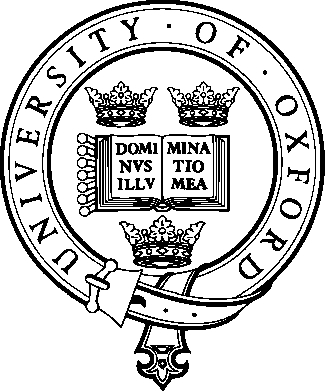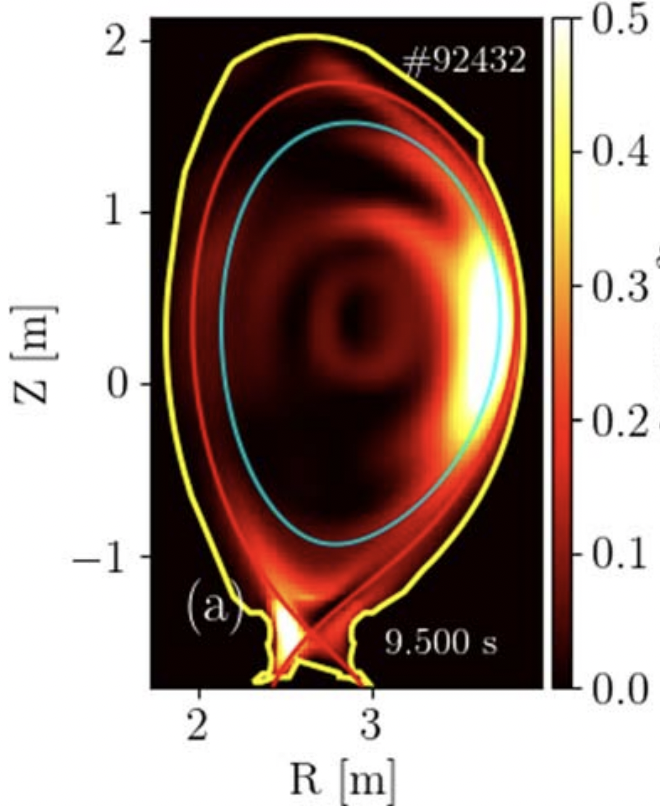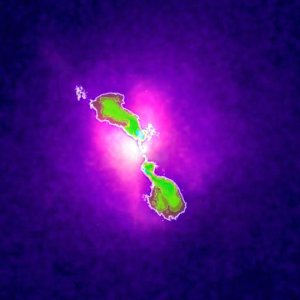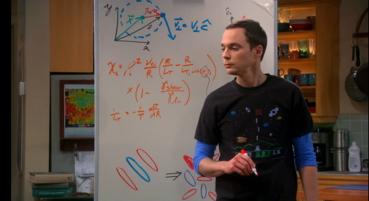

DPhil PROJECTS IN PLASMA PHYSICS
starting in October 2022
Application deadline: 7 January 2022
Oxford Plasma Theory Group welcomes applications for DPhil studies and research in plasma physics in the areas of magnetic confinement fusion (MCF) and plasma astrophysics (including "laboratory astrophysics")
Potential supervisors: Prof Michael Barnes (projects 1, 3), Prof Alexander Schekochihin (projects 2, 3), Prof Gianluca Gregori (project 4), Prof Peter Norreys (project 5)
Size of intake: this depends on various hard-to-predict circumstances, in particular funding arrangements; we accepted 2 fully funded students in 2015, 4 in 2016, 3 in 2017, 3 in 2018, 1 in 2019, 3 in 2020, and 2 in 2021.
*** MORE NEW PROJECTS MAY APPEAR ON THIS PAGE IN DUE COURSE. COME BACK AND CHECK! ***
- If you are interested in MCF (either theoretical or experimental) or generally in plasma physics, apply for a DPhil in Theoretical Physics. Note that Theoretical Physics has three separate DPhil competitions: in particle theory, condensed matter and plasma physics. If you are willing to be considered for more than one of these topics, please state so explicitly in your application form.
- If you are interested in
ICF or laboratory astrophysics (projects with Profs
Gregori and Norreys), you may also apply for a DPhil in Atomic & Laser
Physics.
- If you are interested in plasma astrophysics, apply for a DPhil in Astrophysics. In order to be considered by both subdepartments (Astrophysics and Theoretical Physics) you may also apply for a DPhil in Theoretical Physics (indicating plasma physics as your preferred area) or, if you make a single application to either of the two degrees, indicate clearly at the front of your application form that you wish to be considered by both subdepartments. This will help us identify your application more quickly and consider you for all available projects and funding options across plasma physics. This is also a good strategy if you are generally interested in plasma physics and are flexible between its different areas.
- Internal Oxford scholarships: there
are a number of scholarships in physics available at
Oxford, including Clarendon
Scholarships, the
James Buckee Scholarship at Merton College, the Oxford-Berman
Studentship at University College, and others.
Note that in order to be considered for a
scholarship funded by a particular college, you do
not need to select that college as your college of
first choice. There is one (known to us) exception
to this principle: if
you are studying at a Swiss university,
apply to Lincoln College to be eligible for a Berrow Foundation
Scholarship. If you are from India (or
certain other developing countries), make sure to
indicate on your application that you wish to be
considered for a Felix
Scholarship.
- Choice of college: you may apply to
any college that accepts graduate applicants in
Physics. Choice of college can prove important for
your life as a graduate student: different colleges
offer different levels of support in terms of
research funds, accommodation, social integration
etc. We therefore recommend that you do not leave the
college choice blank, but do some research
on which college suits you best. We are happy to
give informal advice on the matter. Here is the list
of colleges where the faculty members offering
plasma projects this year are Fellows: Merton (A.
Schekochihin), LMH
(G. Gregori), Univ (M.
Barnes and P.
Norreys).
- If you are considering applying for an external scholarship and require our endorsement, in the first instance please contact the supervisor with whom you are most interested in working. Note the opportunities for Commonwealth Scholarships.
- You are welcome to address inquiries on science to any of the project supervisors listed below and on the logistical aspects of applying to Mrs Michelle Jose (but do please check first if your question is perhaps already answered here).
- All graduate students in plasma physics have access to graduate-level courses taught with the Oxford Master Course in Mathematical and Theoretical Physics (to which you can also apply as a stand-alone MSc degree) and the Oxford-Warwick-Imperial Centre for Postgraduate Training in Plasma Physics and High Energy Density Science.

Projects in Fusion Plasmas

Our magnetic-confinement-fusion theory projects are offered jointly with researchers at the U.K.A.E.A. Culham Centre for Fusion Energy (Projects 1-2).
At the application stage, you are not required to (although you may if you wish) indicate which project you prefer --- we will consider all applicants purely on intellectual merit. If you are offered admission, we will strive to give you the opportunity to work on the project of your choice. Note that the project descriptions given below are not set in stone and we are willing to discuss modifications and adjustments to them that might better reflect your interests and inclinations.
1. Plasma
physics at the edge
Supervisor: Prof Michael Barnes
UKAEA co-supervisor: Dr John Omotani
2. Electron heat transport in tokamak edge pedestals
Supervisor: Prof Alexander Schekochihin
UKAEA co-supervisor: Dr Anthony Field
Background Reading:
1. A. R. Field et al., "The dependence of exhaust power components on edge gradients in JET-C and JET-ILW H-mode plasmas," PPCF 62, 055010 (2020)
2. C. J. Ham et al., "Towards understanding reactor relevant tokamak pedestals", Nucl. Fusion 61, 096013 (2021)
3. G. J. Colyer et al., "Collisionality scaling of the electron heat flux in ETG turbulence", PPCF 59, 055002 (2017)
4. F. Jenko et al., "Critical gradient formula for toroidal electron temperature gradient modes", Phys. Plasmas 8, 4096 (2001)
5. J. Parisi et al., "Toroidal and slab ETG instability dominance in the linear spectrum of JET-ILW pedestals", Nucl. Fusion 60, 126045 (2020)
6. D. R. Hatch et al., "Direct gyrokinetic comparison of pedestal transport in JET with carbon and ITER-like walls", PPCF 59, 086056 (2019)
7. W. Guttenfelder et al., "Testing predictions of electron scale turbulent pedestal transport in two DIII-D ELMy H-modes", Nucl. Fusion 61, 056005 (2021)
Supervisor: Prof Michael Barnes
UKAEA co-supervisor: Dr John Omotani
2. Electron heat transport in tokamak edge pedestals
Supervisor: Prof Alexander Schekochihin
UKAEA co-supervisor: Dr Anthony Field
| In the high-confinement regime of
tokamak plasmas---essential to achieve a burning
plasma---a transport barrier forms at the edge of
the plasma, believed to be caused by suppression of
ion-scale turbulence by pressure-gradient-driven
sheared flows. The physics of the resulting edge
"pedestal" region sets the confinement properties of
the whole plasma and is thus pivotal for the entire
device. The pedestal is a complex nonlinear system
characterised by an interplay between steep
equilibrium gradients (of density and temperature)
and the turbulence that they trigger [1,2,3]---the
turbulent particle and heat fluxes caused by this
turbulence in turn decide the size of the gradients.
A critical electron temperature gradient,
proportional to the density gradient [4], is
required for the linear instability [5] that drives
electron-scale ETG turbulence and hence a finite
heat flux. The formation of the electron-temperature
pedestal is therefore intimately related to that of
the density pedestal. Nonlinear gyrokinetic
simulations [6,7] show that at significantly steeper
gradients than the linear threshold, above the
experimental operating point, the heat flux
increases faster than linearly with the driving
gradient, i.e., transport becomes "stiff", clamping
the profiles to this nonlinear threshold. The
existence of this threshold is thought to be related
to the appearance of modes with a high parallel
wavenumber, which are resonant with the parallel
electron motion. This project's aim is to sort out
the fundamental physics behind these phenomena and
hence their quantitative dependence on the
equilibrium parameters. Detailed comparisons of the
outcome with experimental pedestal profile data from
JET-ILW and MAST-U can be made over a range of
conditions. Such information, suitably
parameterised, can then be used to develop a reduced
model of the pedestal, which is required to design
future burning-plasma devices, e.g., STEP. |
|
 |
Background Reading:
1. A. R. Field et al., "The dependence of exhaust power components on edge gradients in JET-C and JET-ILW H-mode plasmas," PPCF 62, 055010 (2020)
2. C. J. Ham et al., "Towards understanding reactor relevant tokamak pedestals", Nucl. Fusion 61, 096013 (2021)
3. G. J. Colyer et al., "Collisionality scaling of the electron heat flux in ETG turbulence", PPCF 59, 055002 (2017)
4. F. Jenko et al., "Critical gradient formula for toroidal electron temperature gradient modes", Phys. Plasmas 8, 4096 (2001)
5. J. Parisi et al., "Toroidal and slab ETG instability dominance in the linear spectrum of JET-ILW pedestals", Nucl. Fusion 60, 126045 (2020)
6. D. R. Hatch et al., "Direct gyrokinetic comparison of pedestal transport in JET with carbon and ITER-like walls", PPCF 59, 086056 (2019)
7. W. Guttenfelder et al., "Testing predictions of electron scale turbulent pedestal transport in two DIII-D ELMy H-modes", Nucl. Fusion 61, 056005 (2021)

Projects in Plasma Astrophysics and Laser Plasmas

Candidates interested in any of these projects or generally in plasma astrophysics, astrophysical turbulence and/or dynamo theory are welcome to get in touch with prospective supervisors for further information. A more bespoke project can be designed to align with the inclinations and interests of the student (for example how much emphasis is placed on analytical vs. numerical methods or kinetic theory vs. fluid dynamics, etc., is negotiable).
3.
Free-energy flows in turbulent astrophysical plasmas
Supervisors: Prof Michael Barnes and Prof Alexander Schekochihin
(for this project, you may also apply for a DPhil in Astrophysics)
In magnetised astrophysical plasmas, there is a turbulent cascade of electromagnetic fluctuations carrying free energy from large to small scales. The energy is typically extracted from large-scale sources (e.g., in the solar wind, the violent activity in the Sun's corona; in accretion discs, the Keplerian shear flow; in galaxy clusters, outbursts from active galactic nuclei) and deposited into heat---the internal energy of ions and electrons. In order for this dissipation of energy to happen, the energy must reach small scales---in weakly collisional plasmas, these are small scales in the 6D kinetic phase space, i.e., what emerges is large spatial gradients of electric and magnetic fields and large gradients of the particle distribution functions with respect to velocities. This prompts two very fundamental questions: (1) how does the energy flow through the 6D phase space and what therefore is the structure of the fluctuations in this space: their spectra, phase-space correlation functions etc. (these fluctuations are best observed in the solar wind, but we can measure density and magnetic fluctuations even in extragalactic plasmas, via X-ray and radio observations); (2) when turbulent fluctuations are dissipated into particle heat, how is their energy partitioned between various species of particles that populate the plasma: electrons, bulk ions, minority ions, fast non-thermal particles (e.g., cosmic rays). The latter question is particularly important for extragalactic plasmas because all we can observe is radiation from the particles and knowing where the internal energy of each species came from is key to constructing and verifying theories both of turbulence and of macroscale dynamics and thermodynamics. This project has an analytical and a numerical dimension (which of these will dominate depends on the student's inclinations). Analytically, we will work out a theory of phase space cascade at spatial scales between the ion and electron Larmor scales. Numerically, we will simulate this cascade using "gyrokinetic" equations---an approach in which we average over the Larmor motion and calculate the distribution function of "Larmor rings of charge" rather than particles (this reduces the dimension of phase space to 5D, making theory more tractable and numerics more affordable).
Background Reading:
1. A. A. Schekochihin et al., "Astrophysical gyrokinetics: kinetic and fluid turbulent cascades in magnetized weakly collisional plasmas," Astrophys. J. Suppl. 182, 310 (2009)
2. A. A. Schekochihin et al., "Phase mixing vs. nonlinear advection in drift-kinetic plasma turbulence," J. Plasma Phys. 82, 905820212 (2016) (2019 IoP Payne-Gaposchkin Prize)
3. Y. Kawazura, M. Barnes, and A. A. Schekochihin, "Thermal disequilibration of ions and electrons by collisionless plasma turbulence," PNAS 116, 771 (2019)
4. R. Meyrand, A. Kanekar, W. Dorland, and A. A. Schekochihin, "Fluidization of collisionless plasma turbulence," PNAS 116, 1185 (2019)
5. A. A. Schekochihin, Y. Kawazura, and M. A. Barnes, "Constraints on ion vs. electron heating by plasma turbulence at low beta," J. Plasma Phys. 85, 905850303 (2019)
Supervisors: Prof Michael Barnes and Prof Alexander Schekochihin
(for this project, you may also apply for a DPhil in Astrophysics)
In magnetised astrophysical plasmas, there is a turbulent cascade of electromagnetic fluctuations carrying free energy from large to small scales. The energy is typically extracted from large-scale sources (e.g., in the solar wind, the violent activity in the Sun's corona; in accretion discs, the Keplerian shear flow; in galaxy clusters, outbursts from active galactic nuclei) and deposited into heat---the internal energy of ions and electrons. In order for this dissipation of energy to happen, the energy must reach small scales---in weakly collisional plasmas, these are small scales in the 6D kinetic phase space, i.e., what emerges is large spatial gradients of electric and magnetic fields and large gradients of the particle distribution functions with respect to velocities. This prompts two very fundamental questions: (1) how does the energy flow through the 6D phase space and what therefore is the structure of the fluctuations in this space: their spectra, phase-space correlation functions etc. (these fluctuations are best observed in the solar wind, but we can measure density and magnetic fluctuations even in extragalactic plasmas, via X-ray and radio observations); (2) when turbulent fluctuations are dissipated into particle heat, how is their energy partitioned between various species of particles that populate the plasma: electrons, bulk ions, minority ions, fast non-thermal particles (e.g., cosmic rays). The latter question is particularly important for extragalactic plasmas because all we can observe is radiation from the particles and knowing where the internal energy of each species came from is key to constructing and verifying theories both of turbulence and of macroscale dynamics and thermodynamics. This project has an analytical and a numerical dimension (which of these will dominate depends on the student's inclinations). Analytically, we will work out a theory of phase space cascade at spatial scales between the ion and electron Larmor scales. Numerically, we will simulate this cascade using "gyrokinetic" equations---an approach in which we average over the Larmor motion and calculate the distribution function of "Larmor rings of charge" rather than particles (this reduces the dimension of phase space to 5D, making theory more tractable and numerics more affordable).
Background Reading:
1. A. A. Schekochihin et al., "Astrophysical gyrokinetics: kinetic and fluid turbulent cascades in magnetized weakly collisional plasmas," Astrophys. J. Suppl. 182, 310 (2009)
2. A. A. Schekochihin et al., "Phase mixing vs. nonlinear advection in drift-kinetic plasma turbulence," J. Plasma Phys. 82, 905820212 (2016) (2019 IoP Payne-Gaposchkin Prize)
3. Y. Kawazura, M. Barnes, and A. A. Schekochihin, "Thermal disequilibration of ions and electrons by collisionless plasma turbulence," PNAS 116, 771 (2019)
4. R. Meyrand, A. Kanekar, W. Dorland, and A. A. Schekochihin, "Fluidization of collisionless plasma turbulence," PNAS 116, 1185 (2019)
5. A. A. Schekochihin, Y. Kawazura, and M. A. Barnes, "Constraints on ion vs. electron heating by plasma turbulence at low beta," J. Plasma Phys. 85, 905850303 (2019)
4.
Magnetised plasma turbulence: from laser lab to galaxy
clusters
Supervisors: Prof Gianluca Gregori and Prof Alexander Schekochihin
(for this project, you may also apply for a DPhil in Atomic and Laser Physics or a DPhil in Astrophysics)
Supervisors: Prof Gianluca Gregori and Prof Alexander Schekochihin
(for this project, you may also apply for a DPhil in Atomic and Laser Physics or a DPhil in Astrophysics)
There are a number of
possibilities within this project to design, take part in,
and theorise about laboratory experiments employing
laser-produced plasmas to model astrophysical phenomena and
basic, fundamental physical processes in turbulent plasmas.
Recent examples of our work in this field include turbulent
generation of magnetic fields ("dynamo") [1,2], supersonic
turbulence mimicking star-forming molecular clouds [3],
diffusion and acceleration of particles by turbulence [4,5],
suppression of thermal conduction in galaxy-cluster-like
plasmas [6]. Our group has access to several laser
facilities (including the National Ignition Facility, the
largest laser system in the world). Students will also have
access to a laser laboratory on campus, where initial
experiments can be fielded. Depending on the student's
inclinations, it is also possible to pursue a project
focused on theory and/or numerical modelling of plasma
phenomena in astrophysical and laboratory-astrophysical
environments.
Background
Reading:
1. P. Tzeferacos et al., "Laboratory evidence of dynamo amplification of magnetic fields in a turbulent plasma," Nature Comm. 9, 591 (2018) (2019 APS Dawson Prize)
2. A. F. A. Bott et al., "Time-resolved fast turbulent dynamo in a laser plasma," PNAS 118, e2015729118 (2021) (2020 EPS PhD Award in Plasma Physics)
3. T. G. White et al.,"Supersonic plasma turbulence in the laboratory," Nature Comm. 10, 1758 (2019)
4. A. F. A. Bott et al., "Proton imaging of stochastic magnetic fields," J. Plasma Phys. 83, 905830614 (2017)
5. L. E. Chen et al., "Transport of high-energy charged particles through spatially intermittent turbulent magnetic fields," Astrophys. J. 892, 114 (2020)
6. J. Meinecke et al., "Strong suppression of heat conduction in a laboratory analogue of galaxy-cluster turbulent plasma," preprint arXiv:2105.08461
5. Real photon-photon scattering using ultra-intense lasers
Supervisor: Prof Peter Norreys
(for this project, you should apply for a DPhil in Atomic and Laser Physics)
Quantum electrodynamics (QED), described by Feynman as "the jewel of Physics", is an exquisite description which brings together Einstein's special theory of relativity with the non-intuitive world of quantum mechanics. It is one of the most successful models of modern physics, laying the foundations of our understanding of the interactions of matter and light. Yet, despite continuing attempts, one of its key predictions remains unproven by experiment. Classical physics states that light cannot interact with itself the absence of matter---shine two beams of light at each other and they pass through, unaffected. However, QED predicts that photons, particles of light, should be able to scatter off each other even in complete vacuum. If this can be proven experimentally, and the photon scattering patterns analysed, it would provide not only confirmation of our understanding of the Standard Model of Physics, but enable us to explore some theories of "Beyond the Standard Model" physics which are needed to completely explain physical properties of our Universe. We have a four-year project that brings together a team of academic experts from UK and international universities with experienced staff from the Central Laser Facility, the UK's national experimental laser site, first to build and test new laser optics and detection equipment required for these experiments and then use this instrumentation to perform the ultimate experiments using the world's highest power lasers at the "Super-intense Ultrafast Laser Facility" in China. Our team also combines outstanding theorists in Oxford Physics who will create mathematical models for the photon interactions, with leading scientists who have contributed to some of the greatest physical discoveries in recent times, such as the detection of the Higgs boson at the Large Hadron Collider. Together they will enable the optimisation of our experimental procedures, provide predictions on signatures which would be generated by phenomena beyond the standard model of physics and constrain our experimental results. Please apply to join our project for your DPhil and join us in the unique physics investigation.
1. P. Tzeferacos et al., "Laboratory evidence of dynamo amplification of magnetic fields in a turbulent plasma," Nature Comm. 9, 591 (2018) (2019 APS Dawson Prize)
2. A. F. A. Bott et al., "Time-resolved fast turbulent dynamo in a laser plasma," PNAS 118, e2015729118 (2021) (2020 EPS PhD Award in Plasma Physics)
3. T. G. White et al.,"Supersonic plasma turbulence in the laboratory," Nature Comm. 10, 1758 (2019)
4. A. F. A. Bott et al., "Proton imaging of stochastic magnetic fields," J. Plasma Phys. 83, 905830614 (2017)
5. L. E. Chen et al., "Transport of high-energy charged particles through spatially intermittent turbulent magnetic fields," Astrophys. J. 892, 114 (2020)
6. J. Meinecke et al., "Strong suppression of heat conduction in a laboratory analogue of galaxy-cluster turbulent plasma," preprint arXiv:2105.08461
5. Real photon-photon scattering using ultra-intense lasers
Supervisor: Prof Peter Norreys
(for this project, you should apply for a DPhil in Atomic and Laser Physics)
Quantum electrodynamics (QED), described by Feynman as "the jewel of Physics", is an exquisite description which brings together Einstein's special theory of relativity with the non-intuitive world of quantum mechanics. It is one of the most successful models of modern physics, laying the foundations of our understanding of the interactions of matter and light. Yet, despite continuing attempts, one of its key predictions remains unproven by experiment. Classical physics states that light cannot interact with itself the absence of matter---shine two beams of light at each other and they pass through, unaffected. However, QED predicts that photons, particles of light, should be able to scatter off each other even in complete vacuum. If this can be proven experimentally, and the photon scattering patterns analysed, it would provide not only confirmation of our understanding of the Standard Model of Physics, but enable us to explore some theories of "Beyond the Standard Model" physics which are needed to completely explain physical properties of our Universe. We have a four-year project that brings together a team of academic experts from UK and international universities with experienced staff from the Central Laser Facility, the UK's national experimental laser site, first to build and test new laser optics and detection equipment required for these experiments and then use this instrumentation to perform the ultimate experiments using the world's highest power lasers at the "Super-intense Ultrafast Laser Facility" in China. Our team also combines outstanding theorists in Oxford Physics who will create mathematical models for the photon interactions, with leading scientists who have contributed to some of the greatest physical discoveries in recent times, such as the detection of the Higgs boson at the Large Hadron Collider. Together they will enable the optimisation of our experimental procedures, provide predictions on signatures which would be generated by phenomena beyond the standard model of physics and constrain our experimental results. Please apply to join our project for your DPhil and join us in the unique physics investigation.

